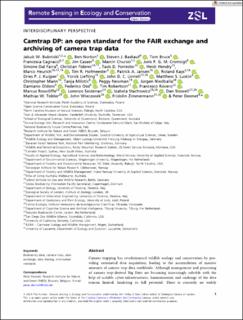Camtrap DP: an open standard for the FAIR exchange and archiving of camera trap data
| dc.contributor.author | Bubnicki, Jakub W. | |
| dc.contributor.author | Norton, Ben | |
| dc.contributor.author | Baskauf, Steven J. | |
| dc.contributor.author | Bruce, Tom | |
| dc.contributor.author | Cagnacci, Francesca | |
| dc.contributor.author | Casaer, Jim | |
| dc.contributor.author | Churski, Marcin | |
| dc.contributor.author | Cromsigt, Joris P. G. M. | |
| dc.contributor.author | Farra, Simone Dal | |
| dc.contributor.author | Fiderer, Christian | |
| dc.contributor.author | Forrester, Tavis D. | |
| dc.contributor.author | Hendry, Heidi | |
| dc.contributor.author | Heurich, Marco Dietmar | |
| dc.contributor.author | Hofmeester, Tim R. | |
| dc.contributor.author | Jansen, Patrick A. | |
| dc.contributor.author | Kays, Roland | |
| dc.contributor.author | Kuijper, Dries P. J. | |
| dc.contributor.author | Liefting, Yorick | |
| dc.contributor.author | Linnell, John Durrus | |
| dc.contributor.author | Luskin, Matthew S. | |
| dc.contributor.author | Mann, Christopher | |
| dc.contributor.author | Milotic, Tanja | |
| dc.contributor.author | Newman, Peggy | |
| dc.contributor.author | Niedballa, Jürgen | |
| dc.contributor.author | Oldoni, Damiano | |
| dc.contributor.author | Ossi, Federico | |
| dc.contributor.author | Robertson, Tim | |
| dc.contributor.author | Rovero, Francesco | |
| dc.contributor.author | Rowcliffe, Marcus | |
| dc.contributor.author | Seidenari, Lorenzo | |
| dc.contributor.author | Stachowicz, Izabela | |
| dc.contributor.author | Stowell, Dan | |
| dc.contributor.author | Tobler, Mathias W. | |
| dc.contributor.author | Wieczorek, John | |
| dc.contributor.author | Zimmermann, Fridolin | |
| dc.contributor.author | Desmet, Peter | |
| dc.date.accessioned | 2023-12-12T11:52:22Z | |
| dc.date.available | 2023-12-12T11:52:22Z | |
| dc.date.created | 2023-12-11T15:58:58Z | |
| dc.date.issued | 2023 | |
| dc.identifier.issn | 2056-3485 | |
| dc.identifier.uri | https://hdl.handle.net/11250/3107083 | |
| dc.description.abstract | Camera trapping has revolutionized wildlife ecology and conservation by providing automated data acquisition, leading to the accumulation of massive amounts of camera trap data worldwide. Although management and processing of camera trap-derived Big Data are becoming increasingly solvable with the help of scalable cyber-infrastructures, harmonization and exchange of the data remain limited, hindering its full potential. There is currently no widely accepted standard for exchanging camera trap data. The only existing proposal, “Camera Trap Metadata Standard” (CTMS), has several technical shortcomings and limited adoption. We present a new data exchange format, the Camera Trap Data Package (Camtrap DP), designed to allow users to easily exchange, harmonize and archive camera trap data at local to global scales. Camtrap DP structures camera trap data in a simple yet flexible data model consisting of three tables (Deployments, Media and Observations) that supports a wide range of camera deployment designs, classification techniques (e.g., human and AI, media-based and event-based) and analytical use cases, from compiling species occurrence data through distribution, occupancy and activity modeling to density estimation. The format further achieves interoperability by building upon existing standards, Frictionless Data Package in particular, which is supported by a suite of open software tools to read and validate data. Camtrap DP is the consensus of a long, in-depth, consultation and outreach process with standard and software developers, the main existing camera trap data management platforms, major players in the field of camera trapping and the Global Biodiversity Information Facility (GBIF). Under the umbrella of the Biodiversity Information Standards (TDWG), Camtrap DP has been developed openly, collaboratively and with version control from the start. We encourage camera trapping users and developers to join the discussion and contribute to the further development and adoption of this standard. Biodiversity data, camera traps, data exchange, data sharing, information standards | en_US |
| dc.language.iso | eng | en_US |
| dc.rights | Navngivelse-Ikkekommersiell 4.0 Internasjonal | * |
| dc.rights.uri | http://creativecommons.org/licenses/by-nc/4.0/deed.no | * |
| dc.subject | biodiversity data | en_US |
| dc.subject | camera trap | en_US |
| dc.subject | data exchange | en_US |
| dc.subject | data sharing | en_US |
| dc.subject | information standards | en_US |
| dc.title | Camtrap DP: an open standard for the FAIR exchange and archiving of camera trap data | en_US |
| dc.type | Peer reviewed | en_US |
| dc.type | Journal article | en_US |
| dc.description.version | publishedVersion | en_US |
| dc.rights.holder | 2023 The Authors. | en_US |
| dc.subject.nsi | VDP::Matematikk og Naturvitenskap: 400::Informasjons- og kommunikasjonsvitenskap: 420 | en_US |
| dc.source.journal | Remote Sensing in Ecology and Conservation | en_US |
| dc.identifier.doi | 10.1002/rse2.374 | |
| dc.identifier.cristin | 2211969 | |
| cristin.ispublished | true | |
| cristin.fulltext | original | |
| cristin.qualitycode | 1 |

